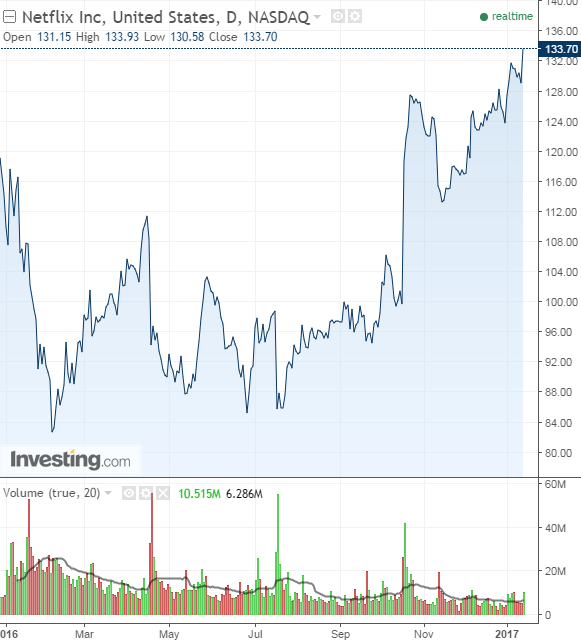by Clement Thibault
Netflix (NASDAQ:NFLX), the DVD rental service turned media streaming company is set to report earnings on Wednesday January 18, after the bell. The expectation for Netflix is to report EPS of $0.13 on $2.46 billion in revenue.

1. User Growth
This was the company's focus during the past few earnings seasons as well, and for good reason. Netflix's subscriber numbers must grow in order for the company to justify its share price and valuation, discussed below. Netflix provides quarterly guidance on this, but the numbers aren't reliable.
They do, however, set a very clear bar for what is considered failure or a success on this metric. Last quarter, Netflix blew away all expectations when it reported 3.2-million new international subscribers, versus 2-million forecast. In Q2, however, Netflix expected 2.5-million new global members, but only hit 1.7 million. This quarter, Netflix expects to add 5.2 million global subscribers, 1.45 from the US plus 3.75 internationally, which would bring its total subscription figure to over 91 million. Last quarter's results seemed to prove that Netflix has the branding and content power to justify its recent subscription price hike, although after misses during three quarters, it will take a few more quarters to definitively issue a judgement call on this.
Netflix is focusing a lot of effort toward localizing content as a driver for international user growth. The two countries it's currently focusing on are Poland and Turkey, with ongoing efforts already up and running for the UK and work on subs and dubs for multiple non-Anglo locations such as France, Germany and Japan. As in previous quarters, Netflix continues to count on its original content as a strong subscriber selling point.
2. Original Content
In truth, Netflix is betting the house on original content, with an expected outlay of of 6-billion dollars in 2017 for this segment, one-billion more than they spent during the course of 2016. Though capital intensive, NFLX's television production group has created some memorable blockbusters including House of Cards, Narcos, and Orange is the New Black. Netflix hopes the megahit train continues to power along smoothly in 2017; there are over 50 shows in production right now, including approximately 20 unscripted, original reality shows, which could appeal to a new, previously untapped demographic.
Netflix has said it wishes to offer approximately 1000 hours of original content versus the 600 it currently provides. If everything goes according to plan, this goal should be totally attainable in 2017. And to be honest, Netflix is not wrong in furthering this goal. After all, what better way to differentiate themselves from the ever-expanding pool of competitors, if not via the amount and quality of the content offered?
3. Competitive Disruption
This is where things could get tricky for Netflix's growth potential. First, it's worth acknowledging the positive.
Netflix is the current leader in SVOD (streaming video on demand). In Q4 2016, its app reached the No.2 spot on Sensor Tower's ranking of apps by revenue for the first time, just behind LINE, a messaging app that operates outside of NFLX's space; Netflix's app tops the app charts on Apple's (NASDAQ:AAPL) iOS operating system, and comes in ninth on Android systems.
The problem, of course is disruption from below. Competitors simply won't just let Netflix remain on top. While Netflix currently owns the number two spot, HBO—with its own stellar array of quality original content— and Hulu—a video subscription service that operates in partnership with Disney (NYSE:DIS), 21st Century Fox (NASDAQ:FOX), Comcast (NASDAQ:CMCSA) and Time Warner (NYSE:TWX)—are also on the list, at numbers 6 and 10 respectively.
Amazon (NASDAQ:AMZN) is another major player with big aspirations for making additional inroads into the streaming market. The e-commerce giant announced in December that its Prime video service will be going global, and is now available in over 200 countries via app and desktop. Amazon's international service will be bundled with Prime membership wherever it's available (across most of Europe and India for example). It will cost $5.99 or €5.99, depending on location—cheaper than Netflix's offering which costs $8 to $10 dollars, location dependent.
It's estimated that Amazon will invest between four to five billion dollars annually on content, giving Netflix a serious run for their own cash outlay. Even Google (NASDAQ:GOOGL) is dipping its toes into original content streaming via YouTube Red, its premium, no-advertising video streaming service, although at this stage it's still far from being a threat to other players in the industry.
Though every company has physical competitors, Netflix faces an additional level of competition...its own valuation. Netflix is now priced for extraordinary future growth, which will surely be harder to achieve the more aggressively competitors work to expand into Netflix's territory.
Conclusion
There's no way of avoiding the obvious here: Netflix is a pricey stock. At $133 dollars a share it has a stratospheric P/E ratio of 360, the third highest on the S&P 500, and even higher than its own three year median P/E ratio of 236.
Analysts believe its forward P/E ratio is 73. We went on record last quarter that Netflix was too pricey at $100, and we stand by that conviction. Not enough has changed within Netflix, even as the market in which it operates becomes more and more crowded.
Since last quarter's positive report, Netflix has experienced an aggressive rally. Its share price jumped from $100 dollars a share to $133 after struggling to stay above the $100 line for more than a week or two in 2016. The highly volatile nature of Netflix's share price come earnings season is another sign the market is just not settled regarding the company's valuation.
In 2016, Netflix dropped over 10% after each of the first three quarterly reports, on failure to meet expectations; it rose 18% after reporting last quarter's positive subscriber growth numbers. As long as the share price is not fundamentally justifiable, and Netflix's price per share keeps moving wildly, we prefer to wait on the sidelines.
Which stock should you buy in your very next trade?
AI computing powers are changing the stock market. Investing.com's ProPicks AI includes 6 winning stock portfolios chosen by our advanced AI. In 2024 alone, ProPicks AI identified 2 stocks that surged over 150%, 4 additional stocks that leaped over 30%, and 3 more that climbed over 25%. Which stock will be the next to soar?
Unlock ProPicks AI
